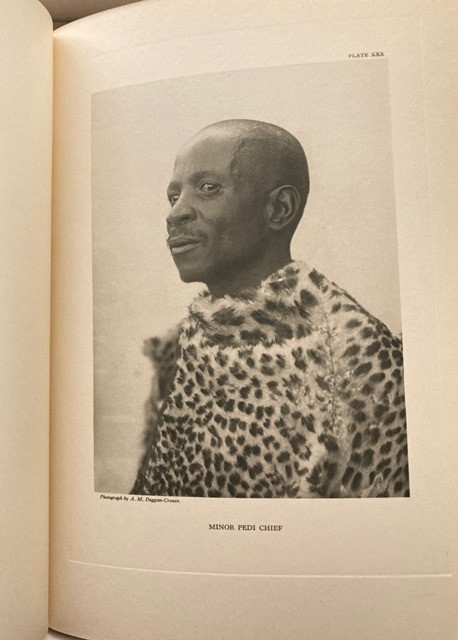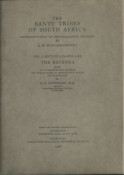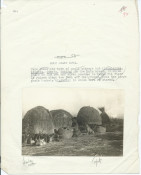4 volumes in 11 parts, containing numbered plates with captioned tissue guards: illustrations, (chiefly portraits). Quarto. Stiff paper wraps. An exceptionally clean, tight set.
Accompanied by two original pages of proofs with original photographs from Vol. III, Section III, Plates XC (Zulu grain huts) and XCVI (A cap of clay), with handwritten annotations and corrections.
Vol. I, Section I, Plates I-XX: THE BAVENDA; with an introductory article on the Bavenda & descriptive notes on the plates by G.P. Lestrade. 1928.
Vol. II, Section I, Plates I-XXVI: THE SUTO-CHUANA TRIBES: sub-group I, the Bechuana; with introductory articles on the Suto-Chuana tribes and the Bechuana by G.P. Lestrade and descriptive notes on the plates. 1929.
Vol. II, Section II, Plates XXVII-LII: THE SUTO-CHUANA TRIBES: sub-group II, the Bapedi (Transvaal Basotho); with an introductory article on the Bapedi and descriptive notes on the plates by Werner Eiselen. 1931.
Vol. II, Section III, Plates LIII-LXXVIII: THE SUTO-CHUANA TRIBES, sub-group III, the Southern Basotho; with an introductory article on the southern Basotho and descriptive notes on the plates by G.P. Lestrade and a bibliography of the southern Basotho by I. Schapera. 1933.
Vol. III, Section I, Plates I-XL: THE NGUNI; introductory article on the Nguni by N.J. van Warmelo; the Ciskei and southern Transkei tribes (Xhosa and Thembu) by W.G. Bennie; and a select bibliography by I. Schapera and W.G. Bennie. 1939.
Vol. III, Section II, Plates XLI-LXXX: THE NGUNI: the Mpondo and Mpondomise; with an introductory article on the Mpondo and Mpondomise, and descriptive notes on the plates by Monica Wilson. 1949.
Vol. III, Section III, Plates LXXXI-CXX: THE NGUNI: the Zulu; with introductory articles on the Zulu, a bibliography, and descriptive notes on the plates by D. McK. Malcolm. 1938.
Vol. III, Section IV, Plates CXXI-CLII: THE NGUNI: the Swazi; with an introductory article on the Swazi and descriptive notes on the plates by Hilda Beemer. 1941.
Vol. III, Section V, Plates CLIII-CXCVIII: THE NGUNI: Baca, Hlubi, Xesibe; with an introductory article on the Baca, Hlubi and Xesibe, a bibliography, and descriptive notes on the plates by W.D. Hammond-Tooke. 1954.
Vol. IV, Section I, Plates I-XL: THE VATHONGA: (The Thonga-Shangaan People); with an introductory article on the Vathonga, a bibliography, and descriptive notes on the plates by Henri-Philippe Junod. 1935.
Vol IV, Section II, Plates XLI-LXXX: THE VACHOPI PEOPLE OF PORTUGUESE EAST AFRICA; with an introductory article on the Vachopi, and a bibliography, and descriptive notes on the plates by Henri-Philippe Junod. 1936.
Alfred Martin Duggan-Cronin (1874-1954) was born in Ireland and educated in England. He arrived in South Africa aged 23 and started work for De Beers in a humble capacity. In 1904 he purchased a camera and began to take photographs of his environment. He became well known to Maria Wilman, the first director of the Alexander McGregor Memorial Museum, who encouraged him to expand his horizons. The First World War intervened and Duggan-Cronin served in both the German West and German East African campaigns. Upon his return from the war, Duggan-Cronin began to travel more widely and in the period between 1919-1938 is thought to have taken over 70 000 photographs but only a very small number were printed and appear in this set, which is a complete collection of all his published work, done in collaboration with the leading anthropologists of the time.
Duggan-Cronin's work has gone through periods of praise and rejection. There is no doubt that he, a product of his time, saw his subjects as representing tribal Africa. He divided his subjects into tribes; and descriptions of them indicate an acceptance of the view that they were distinct peoples. Michael Godby [Kronos 36, p. 54-83] also suggests that Duggan-Cronin was not adverse to supplying props to his subjects and certainly the photographs are posed in very specific ways. However, Duggan-Cronin was one of only a few photographers who recorded black inhabitants of South Africa at this time and he left a published record for posterity.
On a visit to Duggan-Cronin's home in Kimberley (which he had converted to a gallery), General Smuts is reported to have said "You can die now, Cronin, your monument is raised". The Royal family visited the gallery in 1947, as did other notables, including Alan Paton.
Nelson Mandela indicated his support for the restoration of the prints, saying "they [are] a unique representation of the wealth and diversity of our many cultures." As can be seen, the publication of these volumes was staggered over a period of twenty-six years, and the volumes were not produced in sequential order. It is very unusual to find a complete set in such superb condition.
- Binding Condition: Fine
- Overall Condition: Unread
- Size: 29,5 x 21 cm
- Sold By: Select Books
- Contact Person: David McLennan
- Country: South Africa
- Email: [email protected]
- Telephone: 021-4246955
- Preferred Payment Methods: Credit card; EFT
- Trade Associations: SABDA
























